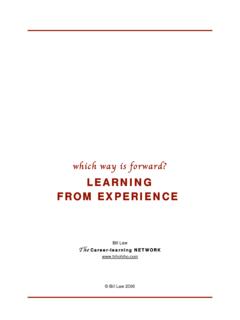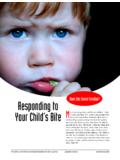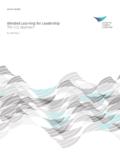Transcription of What's Your Best Learning Experience? What …
1 1 Dunlap, J. C., & Lowenthal, P. R. (2010, April). what s your best Learning experience ? what students stories tell us about engaging teaching and Learning . Paper presented at the annual meeting of the American Education Research Association, Denver, CO. What's your best Learning experience ? what students ' stories Tell Us About Engaging Teaching and Learning Joanna C. Dunlap University of Colorado Denver Patrick Lowenthal University of Colorado Denver Abstract stories help students make sense or meaning out of experience , access prior knowledge, and make connections. Therefore, we start our online courses by having students share their best Learning experience stories .
2 Through sharing and analyzing each others stories , our students have discovered that an engaging Learning experience is learner-centered, contextual, active, social, and supportive. In this session, we will report on the results of this assignment, presented as a series of case stories . We will focus on what students discovered and the resulting instructional design guidelines that inform their practice. This work contributes to our understanding of student engagement by describing students discovery of common instructional strategies that, when applied together, have the potential to lead to engaging Learning experiences.
3 Overview This paper contributes to our understanding of engaging teaching by describing the findings of several exploratory case studies of graduate-student cohorts in our eLearning Design and Implementation online program. At the start of their program, students (who are teachers in K-12 and postsecondary settings, corporate trainers, and instructional designers) are asked to collaboratively complete a specific course assignment designed to help them enhance their use of instructional and teaching strategies in online courses. students shared individual stories recounting their experiences of engaging instruction. Then students worked together in small 2 groups of four to five to mine their collective stories for common themes and attributes that seemed to be at the heart of their engaging Learning experiences.
4 Next, all groups shared their story analyses, and as a large group they analyzed their lists of common themes and attributes, compiling a master list of instructional strategies that support student engagement. Finally, students took the master list and developed an assessment tool for evaluating their own teaching and instructional practice. Archiving the results of this activity across several cohorts, we have determined that the students stories and themes and attributes derived from the stories are consistent. This paper describes the course assignment, the consistent results of the assignment across multiple cohorts, and why the results are useful when considering the design of engaging Learning experiences.
5 The best Learning experience Activity For the past few years, we have started our graduate-level eLearning Design and Implementation program with the following assignment: Part 1. 1) Describe your best Learning experience . Think about your most valuable, effective, and/or engaging Learning experience and in 250-400 words share your Learning story. Don t editorialize or try to explain why you think it was your best Learning experience , just tell the story. 2) Within your group, analyze each person's best Learning experience story. Take time to discover why each particular Learning experience was so special. This may require you to ask probing questions of each person.
6 The goal of this analysis is to uncover a set of underlying instructional themes and attributes working behind the scenes of these Learning experiences. 3) As a group, compile themes and attributes into a list; your list will contribute to providing us with a foundation for the rest of the work we do in this course and beyond. When you design Learning experiences for others, it is important to consider what you instructionally value as a learner and educator. your values based on your experience in the world and on what you know about how people think and learn (from studying the literature) should be reflected in your selection of instructional strategies.
7 For example, if you believe that people learn best in collaborative settings, then your instructional design should include opportunities for collaborative Learning . See if your values and beliefs are actually reflected in your group s collective stories as you analyze them for common themes and attributes. Part 2. Using the story analyses that you did last week in your small groups, work together as a large group to derive a master list of common themes, attributes, and instructional strategies based on your small group lists. Once the master list is completed and vetted, 3 we will convert the list to an assessment tool we will use to assess our instructional design projects.
8 We start the program this way because we want students to grapple with the question, what engages students ? prior to them Learning to use the tools and technologies of online teaching and Learning . Their responses which they arrive at through sharing their own Learning stories and analyzing the collective stories of their peers provide a foundation for their study and application of Learning and instructional design theories. Besides providing insight into the instructional strategies that lead to engaging Learning experiences, students analysis of their stories helps them study new Learning and instructional theories because they are able to tie their new Learning to prior experience and knowledge.
9 In addition, because we use the stories as a foundational framework, students have some buy-in for exploring new theories, and embracing the value and relevance of those new theories in relation to their professional practice. The strength of this activity begins and ends with students stories . Recalling and creating stories are key parts of Learning . We remember by connecting things with our stories , we create by connecting our stories together in unique and memorable (Zull, 2002, p. 228). stories help us make sense or meaning out of experience , with the story form serving as a powerful sense-making tool for educators (Ackerman, Maslin, & Christensen, 1996), in part because they help elicit prior knowledge; stories enable students to access prior knowledge and to make connections.
10 To larger themes and patterns. Using stories affirms the value of prior student experiences both emotionally and cognitively, help[ing] students make their own (Frederick, 2004-2005, p. 1). Related, asking students to share their stories gives them a voice, honoring what they have to contribute to the teaching- Learning relationship and building their confidence and sense of empowerment (Burk, 2000; Davis, 2004; Frederick, 2004-2005). We ask students to engage in formal storytelling because we want them to move beyond the casual exchange of experience and instead participate in critical dialogue. Going beyond simply sharing stories , it is important to encourage students to look at their stories from different [and] ask other members of the class to give their interpretations of the story or try to get the storyteller to scrutinize the assumptions underlying the framing of the story and the tellers own actions in it (Brookfield & Preskill, 1999, p.)






